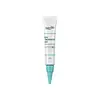What's inside
What's inside
 Key Ingredients
Key Ingredients

 Benefits
Benefits

 Concerns
Concerns

 Ingredients Side-by-side
Ingredients Side-by-side

Water
Skin ConditioningButylene Glycol
HumectantGlycerin
HumectantCyclopentasiloxane
EmollientSqualane
EmollientNiacinamide
SmoothingCetearyl Alcohol
EmollientAmmonium Acryloyldimethyltaurate/Vp Copolymer
Lactobacillus/Rice Ferment
Skin ConditioningPolyglyceryl-6 Distearate
Emulsifying1,2-Hexanediol
Skin ConditioningHydroxyacetophenone
AntioxidantCetearyl Stearate
Skin ConditioningLecithin
EmollientSodium Hyaluronate
HumectantCaffeine
Skin ConditioningCyclodextrin
AbsorbentCollagen
MoisturisingAllantoin
Skin ConditioningPolyglyceryl-3 Beeswax
EmulsifyingCetyl Alcohol
EmollientBeta-Glucan
Skin ConditioningEscin
TonicGlycyrrhiza Uralensis Root Extract
Skin ConditioningPolysorbate 20
EmulsifyingTrehalose
HumectantPropanediol
SolventPhenoxyethanol
PreservativeCentella Asiatica Root Extract
Skin ConditioningEthylhexylglycerin
Skin ConditioningCaprylyl Glycol
EmollientXanthan Gum
EmulsifyingPalmitoyl Tripeptide-1
Skin ConditioningArginine/Lysine Polypeptide
Skin ConditioningWater, Butylene Glycol, Glycerin, Cyclopentasiloxane, Squalane, Niacinamide, Cetearyl Alcohol, Ammonium Acryloyldimethyltaurate/Vp Copolymer, Lactobacillus/Rice Ferment, Polyglyceryl-6 Distearate, 1,2-Hexanediol, Hydroxyacetophenone, Cetearyl Stearate, Lecithin, Sodium Hyaluronate, Caffeine, Cyclodextrin, Collagen, Allantoin, Polyglyceryl-3 Beeswax, Cetyl Alcohol, Beta-Glucan, Escin, Glycyrrhiza Uralensis Root Extract, Polysorbate 20, Trehalose, Propanediol, Phenoxyethanol, Centella Asiatica Root Extract, Ethylhexylglycerin, Caprylyl Glycol, Xanthan Gum, Palmitoyl Tripeptide-1, Arginine/Lysine Polypeptide
Water
Skin ConditioningHydrolyzed Wheat Gluten
MoisturisingCeratonia Siliqua Gum
EmollientSodium Dextran Sulfate
Gel FormingBis-Hydroxyethyl Tromethamine
BufferingAesculus Hippocastanum Seed Extract
Skin ConditioningHydrolyzed Soy Protein
HumectantCentaurea Cyanus Flower Extract
AstringentCucumis Sativus Fruit Extract
EmollientGlycerin
HumectantChamomilla Recutita Flower Water
MaskingPEG-40 Hydrogenated Castor Oil
EmulsifyingPropylene Glycol
HumectantAcrylates/C10-30 Alkyl Acrylate Crosspolymer
Emulsion StabilisingAloe Barbadensis Leaf Juice Powder
Skin ConditioningRetinyl Palmitate
Skin ConditioningArachis Hypogaea Oil
Skin ConditioningTocopherol
AntioxidantUbiquinone
AntioxidantGlycyrrhiza Glabra Root Extract
BleachingHydroxyethylcellulose
Emulsion StabilisingCitric Acid
BufferingTriethanolamine
BufferingParfum
MaskingEthylhexylglycerin
Skin ConditioningTrideceth-9
Emulsifying1,2-Hexanediol
Skin ConditioningBisabolol
MaskingSodium Benzoate
MaskingPotassium Sorbate
PreservativeSorbitan Caprylate
EmulsifyingWater, Hydrolyzed Wheat Gluten, Ceratonia Siliqua Gum, Sodium Dextran Sulfate, Bis-Hydroxyethyl Tromethamine, Aesculus Hippocastanum Seed Extract, Hydrolyzed Soy Protein, Centaurea Cyanus Flower Extract, Cucumis Sativus Fruit Extract, Glycerin, Chamomilla Recutita Flower Water, PEG-40 Hydrogenated Castor Oil, Propylene Glycol, Acrylates/C10-30 Alkyl Acrylate Crosspolymer, Aloe Barbadensis Leaf Juice Powder, Retinyl Palmitate, Arachis Hypogaea Oil, Tocopherol, Ubiquinone, Glycyrrhiza Glabra Root Extract, Hydroxyethylcellulose, Citric Acid, Triethanolamine, Parfum, Ethylhexylglycerin, Trideceth-9, 1,2-Hexanediol, Bisabolol, Sodium Benzoate, Potassium Sorbate, Sorbitan Caprylate
 Reviews
Reviews

Ingredients Explained
These ingredients are found in both products.
Ingredients higher up in an ingredient list are typically present in a larger amount.
1,2-Hexanediol is a synthetic liquid and another multi-functional powerhouse.
It is a:
- Humectant, drawing moisture into the skin
- Emollient, helping to soften skin
- Solvent, dispersing and stabilizing formulas
- Preservative booster, enhancing the antimicrobial activity of other preservatives
Ethylhexylglycerin (we can't pronounce this either) is commonly used as a preservative and skin softener. It is derived from glyceryl.
You might see Ethylhexylglycerin often paired with other preservatives such as phenoxyethanol. Ethylhexylglycerin has been found to increase the effectiveness of these other preservatives.
Glycerin is already naturally found in your skin. It helps moisturize and protect your skin.
A study from 2016 found glycerin to be more effective as a humectant than AHAs and hyaluronic acid.
As a humectant, it helps the skin stay hydrated by pulling moisture to your skin. The low molecular weight of glycerin allows it to pull moisture into the deeper layers of your skin.
Hydrated skin improves your skin barrier; Your skin barrier helps protect against irritants and bacteria.
Glycerin has also been found to have antimicrobial and antiviral properties. Due to these properties, glycerin is often used in wound and burn treatments.
In cosmetics, glycerin is usually derived from plants such as soybean or palm. However, it can also be sourced from animals, such as tallow or animal fat.
This ingredient is organic, colorless, odorless, and non-toxic.
Glycerin is the name for this ingredient in American English. British English uses Glycerol/Glycerine.
Learn more about GlycerinWater. It's the most common cosmetic ingredient of all. You'll usually see it at the top of ingredient lists, meaning that it makes up the largest part of the product.
So why is it so popular? Water most often acts as a solvent - this means that it helps dissolve other ingredients into the formulation.
You'll also recognize water as that liquid we all need to stay alive. If you see this, drink a glass of water. Stay hydrated!
Learn more about Water